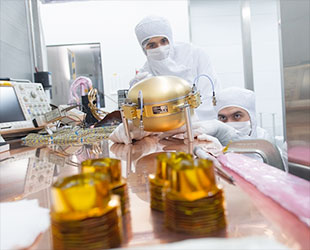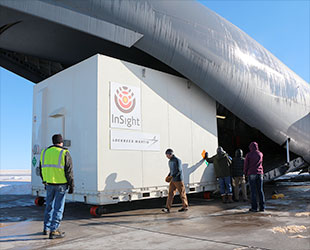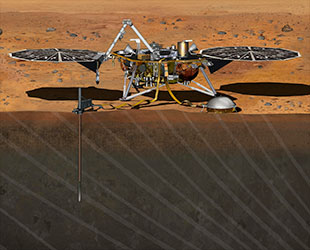December 22, 2015 — A NASA mission to study the deep interior of Mars has been grounded on Earth for at least the next two years due to a leak discovered in one of the robotic lander's sensitive scientific instruments.
NASA's Interior Exploration using Seismic Investigations, Geodesy and Heat Transport, or InSight, spacecraft was scheduled to launch to the Red Planet in March 2016. On Tuesday (Dec. 22), NASA managers decided to delay the mission after running out of time to troubleshoot a problem with its vacuum-sealed seismometer, which was designed and is being provided by France's Centre National Études Spatiales (CNES).
"Unfortunately, since last August, we have been fighting a series of very small leaks, but leaks that were big enough that we wouldn't be able to accomplish our mission," John Grunsfeld, NASA's associate administrator for the science mission directorate and a former astronaut, told reporters during a call on Tuesday. "It is close enough to launch that we unfortunately do not have enough time to identify the leak, fix it, recover and still make it to the launch pad."

InSight's Seismic Experiment for Interior Structure (SEIS) is seen being tested in the CNES facilities outside of Paris. (CNES) |
The Seismic Experiment for Interior Structure (SEIS), one of InSight's two science instruments (the other, a heat flow experiment provided by Germany), is equipped with three high-sensitivity seismometers enclosed in a sealed sphere. The seismometers need to operate in a vacuum in order to provide sensitivity to ground motions as small as the width of an atom.
A small leak in the sphere discovered earlier this year was repaired and the team was hopeful the most recent fix also would be successful. However, during testing on Monday in extreme cold temperature (-49 degrees Fahrenheit/-45 degrees Celsius) the sphere again failed to hold a vacuum.
"I feel bad for our partners in France, who have worked so hard to get us to the point where we thought we'd be able to make the 2016 launch," Grunsfeld said. "It is not to be, but at least we are not on our way to Mars and discovering the leak. We are able to solve it here, on Earth, before we go."
The relative positions of Earth and Mars are such that they are most favorable for launching missions between the two planets for only a few weeks every 26 months. For InSight, that 2016 launch window existed from March 4 to March 30.
The next opportunity for the mission to launch would be in the May 2018 timeframe.

The InSight spacecraft was shipped to Vandenberg Air Force Base on Dec. 16, 2015. It will soon ship back to Denver, Colorado to wait for its next opportunity to launch. (Lockheed Martin) |
"This is a case where alignment of the planets matters," said Grunsfeld. "Every opportunity isn't equal because our orbits are slightly eccentric, and so the 2018 opportunity is actually energetically more favorable. It might mean a little bit wider launch window and opportunities for us."
That is, if the InSight mission is able to proceed. Assuming the cause of the leak can be repaired, something both the teams at NASA and CNES feel is likely, the launch delay introduces a potential new problem: the budget.
As part of NASA's Discovery program, the InSight mission is cost-capped at $675 million, which includes all phases, from development to launch to post-landing data analysis. To date, InSight has already cost $525 million.
"That is a question that's on the table that we have to work through our normal processes," explained Grunsfeld. "But before we can even go through that discussion, we have to understand what the cost impacts are."

Artist's concept of the InSight lander deployed on Mars. (NASA) |
As testing of the SEIS instrument continues at the CNES facilities just outside Paris, the InSight spacecraft itself will be returned from Vandenberg Air Force Base in California, where it was soon to begin being prepared for launch, to Lockheed Martin in Denver, Colorado, where it was built. There it wait for the next two years.
The InSight mission was to investigate whether the core of Mars is solid or liquid like Earth's and why Mars' crust is not divided into tectonic plates that drift like on the Earth. Detailed knowledge of the interior of Mars in comparison to Earth will help scientists understand better how terrestrial planets form and evolve, as well better prepare for the day astronauts are sent to live on the Red Planet.
"I sort of see this [delay] as a minor setback rather than a disaster," said Bruce Banerdt, InSight principal investigator at NASA's Jet Propulsion Laboratory (JPL) in California. "It is not a disaster. It is just a hiccup on our path to getting this kind of science and this kind of understanding of our solar system."
